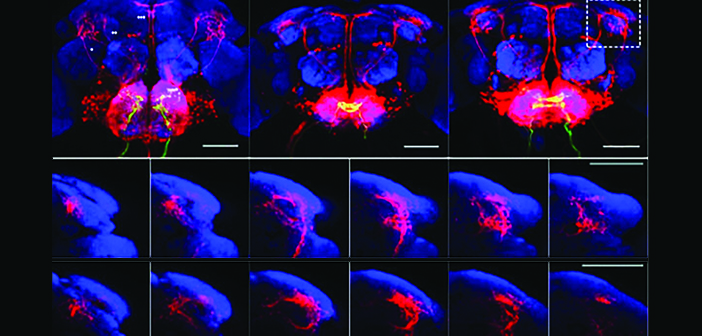New brain imaging technology helps researchers understand brain processes and behavior.
Taste matters to fruit flies, just as it does to humans: like people, the flies tend to seek out and consume sweet-tasting foods and reject foods that taste bitter. However, little is known about how sweet and bitter tastes are represented by the brain circuits that link sensation to behavior.
In a new study published in Current Biology, researchers at Brown University described how they developed a new imaging technique and used it to map the neural activity of fruit flies in response to sweet and bitter tastes.
“These results show that the way fly brains encode the taste of food is more complex than we had anticipated,” says study author Nathaniel Snell PhD’21, who conducted the research as part of his doctoral thesis in neuroscience.
Just as significant as the researchers’ findings is the method they used, says Gilad Barnea, PhD, the Sidney A. Fox and Dorothea Doctors Fox Professor of Ophthalmology and Visual Science, a professor of neuroscience, and the director of the Center for the Neurobiology of Cells and Circuits at the Carney Institute for Brain Science.
To learn more about the brain processes that govern the flies’ reaction to taste sensations, Barnea, Snell, and a group of graduate and undergraduate students in Barnea’s lab developed a new imaging technique called “trans-Tango(activity).” This is an adaptation of trans-Tango, a versatile technology invented by the Barnea lab that is used to trace neural circuits in the brain. Barnea said trans-Tango(activity) takes the understanding to a new level by revealing how specific neurons in the circuits respond to stimuli.
The brain response to stimuli is like a relay, Barnea explains: The “stick” passes from one neuron to the next, and then to the next, and so on. Previous techniques could identify a neuron with the stick, but not who gave the stick to that neuron.
“Trans-Tango(activity) allowed us to selectively look at the second-order neurons in the circuit, so we could focus on how they responded to sweet and bitter tastes,” Barnea says.
Because the reaction to sweet and bitter tastes is so different, the researchers’ expectation was that the neural activity along the circuits mediating those reactions would be entirely disparate as well, he says. But trans-Tango(activity) revealed some overlap of neural activity already in second-order neurons in these circuits in response to the two tastes.
Barnea says that some of the results may show how flies know to avoid a particular rotten, poisonous, or otherwise bad section of a food, for example. Overall, he says that the study findings underscore the importance of the sophisticated and refined processes of taste.
“You have to remember that eating, or feeding, is an activity where you—whether you are a fly or a human—cannot make mistakes,” he says. “If you consume something bad for you, it can be detrimental. Anyone who has ever paid dearly after eating a bad mussel can confirm this. So the ability to know to avoid certain foods, or even certain areas or parts of food, is important for the survival of the species.”




